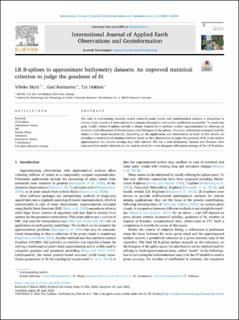| dc.contributor.author | Skytt, Vibeke | |
| dc.contributor.author | Kermarrec, , Gael | |
| dc.contributor.author | Dokken, Tor | |
| dc.date.accessioned | 2022-10-21T13:36:40Z | |
| dc.date.available | 2022-10-21T13:36:40Z | |
| dc.date.created | 2022-07-01T07:50:13Z | |
| dc.date.issued | 2022 | |
| dc.identifier.citation | International Journal of Applied Earth Observation and Geoinformation. 2022, 112, 102894. | en_US |
| dc.identifier.issn | 1569-8432 | |
| dc.identifier.uri | https://hdl.handle.net/11250/3027631 | |
| dc.description.abstract | The task of representing remotely sensed scattered point clouds with mathematical surfaces is ubiquitous to reduce a high number of observations to a compact description with as few coefficients as possible. To reach that goal, locally refined B-splines provide a simple framework to perform surface approximation by allowing an iterative local refinement. Different setups exist (bidegree of the splines, tolerance, refinement strategies) and the choice is often made heuristically, depending on the applications and observations at hand. In this article, we introduce a statistical information criterion based on the t-distribution to judge the goodness of fit of the surface approximation for remote sensing data with outliers. We use a real bathymetry dataset and illustrate how concepts from model selection can be used to select the most adequate refinement strategy of the LR B-splines. | en_US |
| dc.language.iso | eng | en_US |
| dc.publisher | Elsevier | en_US |
| dc.rights | Navngivelse 4.0 Internasjonal | * |
| dc.rights.uri | http://creativecommons.org/licenses/by/4.0/deed.no | * |
| dc.subject | Sonar | en_US |
| dc.subject | Sonar | en_US |
| dc.subject | Big Data | en_US |
| dc.subject | Big Data | en_US |
| dc.subject | Splines | en_US |
| dc.subject | Splines | en_US |
| dc.subject | Approksimasjonsteori | en_US |
| dc.subject | Approximation theory | en_US |
| dc.subject | Lidar | en_US |
| dc.subject | Lidar | en_US |
| dc.title | LR B-splines to approximate bathymetry datasets: An improved statistical criterion to judge the goodness of fit | en_US |
| dc.title.alternative | LR B-splines to approximate bathymetry datasets: An improved statistical criterion to judge the goodness of fit | en_US |
| dc.type | Peer reviewed | en_US |
| dc.type | Journal article | en_US |
| dc.description.version | publishedVersion | en_US |
| dc.rights.holder | © 2022 The Authors | en_US |
| dc.subject.nsi | VDP::Algoritmer og beregnbarhetsteori: 422 | en_US |
| dc.subject.nsi | VDP::Algorithms and computability theory: 422 | en_US |
| dc.subject.nsi | VDP::Algoritmer og beregnbarhetsteori: 422 | en_US |
| dc.subject.nsi | VDP::Algorithms and computability theory: 422 | en_US |
| dc.subject.nsi | VDP::Algoritmer og beregnbarhetsteori: 422 | en_US |
| dc.subject.nsi | VDP::Algorithms and computability theory: 422 | en_US |
| dc.subject.nsi | VDP::Algoritmer og beregnbarhetsteori: 422 | en_US |
| dc.subject.nsi | VDP::Algorithms and computability theory: 422 | en_US |
| dc.source.pagenumber | 8 | en_US |
| dc.source.volume | 112 | en_US |
| dc.source.journal | International Journal of Applied Earth Observation and Geoinformation | en_US |
| dc.identifier.doi | 10.1016/j.jag.2022.102894 | |
| dc.identifier.cristin | 2036498 | |
| dc.relation.project | Norges forskningsråd: 270922 | en_US |
| dc.source.articlenumber | 102894 | en_US |
| cristin.ispublished | true | |
| cristin.fulltext | original | |
| cristin.qualitycode | 1 | |

